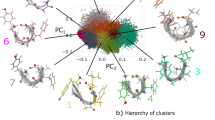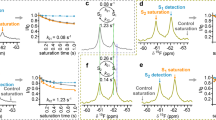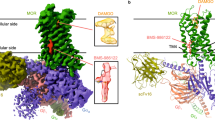Abstract
ENKEPHALIN, an endogenous pentapeptide which has the analgesic properties of morphine1, has recently been isolated, purified and characterised both chemically and pharmacologically2,3. The fact that enkephalin and the opiates interact with the same receptor raises the possibility that the similarity in their function might be based on common structural features4,5. Particular attention has been paid to the geometric relationship between the aromatic ring of the tyrosine residue and the terminal amino group of enkephalin compared with the known geometry of similar functional groups in morphine. The relative spatial disposition of the phenylalanine and tyrosine aromatic side chains is also of special interest because of the possible resemblance of enkephalin to oripavine4,5. So far, however, no experimental determination of conformational parameters has appeared. Here we report proton magnetic resonance (PMR) studies of Met5-enkephalin which indicate that the methionine amino proton is involved in a hydrogen bond, most probably within a Gly–Gly–Phe–Met type I β turn, but not with a turn involving Tyr–Gly–Gly–Phe as proposed previously6. Although our data exclude a γ turn, they do not rigorously exclude other conformations, especially if these have small statistical weights.
This is a preview of subscription content, access via your institution
Access options
Subscribe to this journal
Receive 51 print issues and online access
$199.00 per year
only $3.90 per issue
Buy this article
- Purchase on Springer Link
- Instant access to full article PDF
Prices may be subject to local taxes which are calculated during checkout
Similar content being viewed by others
References
Belluzi, J. D., et al., Nature, 260, 625–626 (1976).
Hughes, J., et al., Nature, 258, 577–579 (1975).
Waterfield, A. A., Hughes, J., and Kosterlitz, H. W., Nature, 260, 624–625 (1976).
Horn, A. S., and Rodgers, J. R., Nature, 260, 795–797 (1976).
Bradbury, A. F., Smyth, D. G., Snell, C. R., Birdsall, N. J. M., and Hulme, E. C., Nature, 260, 793–795 (1976).
Bradbury, A. F., Smyth, D. G., and Snell, C. R., Nature, 260, 165–166 (1976).
Kopple, K. D., Ohnishi, M., and Go, A., J. Am. chem. Soc., 91, 4264–4272 (1969).
Ohnishi, M., and Urry, D. W., Biochem. biophys. Res. Commun., 36, 194–202 (1969).
Nemethy, G., and Printz, M. P., Macromolecules, 5, 755–758 (1972).
Glickson, J. D., Urry, D. W., Havran, R. T., and Walter, R., Proc. natn. Acad. Sci. U.S.A., 69, 2136–2140 (1972).
Pachler, K. G. R., Spectrochim. Acta, 20, 581 (1964).
Wyssbrod, H. R., and Gibbons, W. A., Survey of Progress in Chemistry, 6, (edit. by Scott, A. I.), 209–325 (Academic, New York and London 1973).
Goldstein, A., Aronow, L., and Kaiman, S. M., Principles of Drug Action, 50–60 (Harper and Row, New York, 1969).
Wessels, P. L., Feeney, J., Gregory, H., and Gormley, J. J., J. chem. Soc. Perkin, II, 1691–1698 (1973).
Author information
Authors and Affiliations
Rights and permissions
About this article
Cite this article
JONES, C., GIBBONS, W. & GARSKY, V. Proton magnetic resonance studies of conformation and flexibility of enkephalin peptides. Nature 262, 779–782 (1976). https://doi.org/10.1038/262779a0
Received:
Accepted:
Published:
Issue Date:
DOI: https://doi.org/10.1038/262779a0
This article is cited by
-
Structure of Leu5-enkephalin bound to a model membrane as determined by high-resolution NMR
Letters in Peptide Science (1995)
-
Characterization of low-energy conformational domains for Met-enkephalin
Journal of Computer-Aided Molecular Design (1992)
-
A supermolecule study of the effect of hydration on the conformational behaviour of leucine-enkephalin
Journal of Computer-Aided Molecular Design (1991)
-
Comparative study of conformational behaviour of leucine and methionine enkephalinamides by1H-nuclear magnetic resonance spectroscopy
Journal of Biosciences (1988)
-
Crystal structure of leucine-enkephalin
Nature (1983)
Comments
By submitting a comment you agree to abide by our Terms and Community Guidelines. If you find something abusive or that does not comply with our terms or guidelines please flag it as inappropriate.



